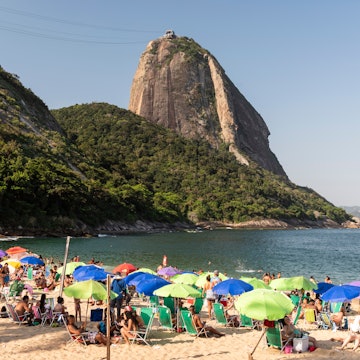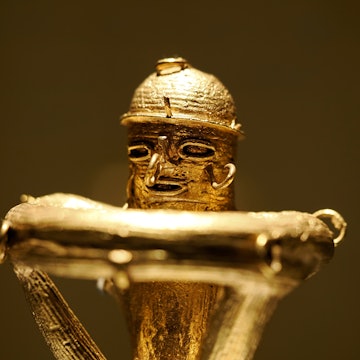

The Colombian capital is a city of vibrant neighborhoods, like colorful La Candelaria. Shutterstock
With eight million people, Bogotá is Colombia’s largest city. Its most vibrant one, too.
While such size makes the place sound intimidating, most of Bogotá’s main attractions are in fact located in a handful of key neighborhoods. These areas hug the green mountains that form this high-altitude city’s eastern spine.
Stay in the historic area of La Candelaria to be within walking distance of Bogotá’s main museums. Or set yourself up in Chicó or Chapinero for more-modern surroundings and easier access to the city’s top-notch restaurants and nightlife. Book a room or short-term rental in laid-back Teusaquillo to get a feel for how Bogotanos live.
Here are six of the best neighborhoods to check out in Colombia’s capital.

1. La Candelaria
Best for museums and historical sites
Bogotá’s historic core, La Candelaria can feel like a village out of the past. Yet today, its narrow streets and colorful colonial-era homes have become inexpensive bars and cafés.
Get an introduction to the city by taking a walking tour focusing on Colombia’s history, or a graffiti tour that will show you the range of vibrant street art in the district.
La Candelaria is also home to the Museo del Oro, one of Colombia’s star attractions; the Museo Botero, showcasing works by perhaps Colombia’s most famous artist; and the stately Plaza de Bolívar, surrounded by government ministries and the historic cathedral.
A short taxi ride will take you to the cable car that ascends to the top of Monserrate.
With plenty of hostels and budget hotels and such easy access to the main attractions, La Candelaria is a central place to stay. The neighborhood gets eerily quiet on weeknights, however, when university students and government workers who commute to the neighborhood are home.
Some of Bogotá’s best music venues are located just a few blocks from La Candelaria, including Casa Quiebra Canto, which regularly features live bands playing ska, reggae, salsa and Colombian rhythms. El Goce Pagano, one of Bogotá’s iconic salsa clubs, is also a short walk away.
2. Teusaquillo
Best for local life
Tudor-style homes once inhabited by upper class families stand next to 1970s-vintage apartment buildings and small row houses in Teusaquillo, a leafy neighborhood just a 15-minute cab ride from the city center.
The area is popular with young professionals, intellectuals and university students. Life in Teusaquillo revolves around the Park Way, an elongated green space that stretches for about 10 blocks and is lined by restaurants, cafes and a couple of theaters.
Food options are abundant and various here; top choices include Pakistani restaurant Curry Masala, Argentine cafe Groso and Chalet Suizo, a Swiss eatery in the shape of a chalet. The neighborhood also boasts many traditional bakeries and inexpensive roasted-chicken joints – throwbacks to its less cosmopolitan days.
With its relaxed vibe and lack of tourist attractions, Teusaquillo is a good spot for those who want to experience life in a traditional – if somewhat trendy – Bogotá neighborhood. You can hang out at a shop that serves dozens of tea varieties, and end the day at one of the neighborhood’s craft breweries.
3. Chapinero and Zona G
Best for restaurants and LBGTIQ spots
Chapinero is located about halfway between the city center and northern Bogotá, and includes quiet residential areas, modern office buildings and streets teeming with nightlife.
Around Calle 60, the central area of Chapinero is home to Bogotá’s largest concentration of gay bars. It’s where you’ll find Theatron, a five-story building with a full 19 dance floors – which likely earns it its self-awarded title of “the largest gay-themed nightclub in Latin America.”
Located to the east of the long avenue known as Carrera Septima and closer to the mountains, Chapinero Alto is way more quiet, and dotted with appealing restaurants. These include the award-winning Leo, a top spot for contemporary Colombian cuisine.
A few blocks further to the north, Zona G is a strip of six blocks famous for its restaurants and harmonious red-brick buildings. Central Chapinero has plenty of budget hotels, while mid-range options and luxury properties prevail in Chapinero Alto and the Zona G.
Head up into the hills to find Quebrada La Vieja, one of the city’s most popular hiking areas, with a trail that leads up into the cloud-forested mountains that border Bogotá. You can access the path for free every morning, though you do need to reserve a spot online.

4. Chicó
Best for parks and nightlife
Just north of Chapinero, Chicó is an elegant neighborhood with leafy streets, quiet parks, chic hotels and plenty of coworking spaces – making it a nice option for business travelers and digital nomads.
The busiest part of Chicó is the Zona T, a pedestrian-only stretch behind the Centro Andino mall packed with restaurants and nightclubs catering to all sorts of musical tastes.
Zona T is popular with Bogotá’s young (and not-so-young) revelers, drawn in by the neighborhood's several live-music venues here, such as 4.40 Music Hall, and the Mexican-themed La Chula.
On the southern side of Zona T, the Recreo Mall is home to Andrés Carne de Res, a landmark Bogotá restaurant with sizzling steaks and over-the-top decor that turns into a dance club at night.
For more peace and quiet, stay near Parque El Virrey, a 3km(2-mile)-long park that crosses much of Chicó and is a favorite spot for joggers and dog walkers. The park was recently outfitted with trail signage that provides details on local trees and birdlife.
Museo el Chicó, an old hacienda with stone fountains, is also a highlight of this neighborhood. The hacienda’s carefully preserved 18th-century structure now features art and photography exhibits.

5. Usaquén
Best for day trips, handicrafts and souvenir shopping
Usaquén was its own town until the second half of the 20th century, when it was integrated into ever-growing Bogotá.
The cobblestone streets and 19th-century church of its main square still give it the feel of a provincial Colombian pueblo. The area around the square is packed with bars and chic restaurants popular with locals.
The neighborhood buzzes with activity on weekends when dozens of artists and merchants set up stalls in its narrow streets, selling all kinds of gorgeous things, including hand-painted coasters, hammocks, essential oils and coffee cups.
Usaquén is located on Bogotá’s northern end, which also makes it a convenient place to stay for those who want to take day trips to “salt cathedral” at Zipaquirá, Suesca or Lake Guatavita. The tourist train that goes to Zipaquirá on weekends has a station in Usaquén, near the Santa Ana shopping mall.
6. San Felipe
Best for art galleries and tejo bars
This up-and-coming neighborhood is a bit distant from Bogotá’s main attractions, yet it’s a good place to spend a chill afternoon checking out art galleries and cafes that have lately popped up around the main square.
San Felipe is also a good place to play tejo, a game that some news outlets have described as Colombia’s “national sport.”
In reality, tejo is closer to a bar game than an athletic pursuit. It involves hanging out with friends, drinking beer and throwing a heavy puck at a clay board that has a bull’s-eye on it…and some small envelopes that are filled with gunpowder.
Hit the envelopes and – boom! You get an explosion. And a couple of points, too.
San Felipe has a couple of tejo bars that are popular with locals, including Tejo La Embajada, which updates the rural game with craft beer, cocktails and a live DJ on weekends.
















